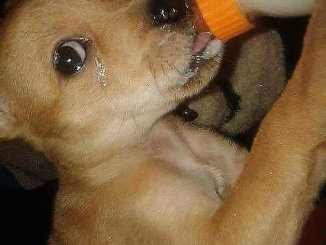The two-year-old dog became lethargic, thin and listless, deteriorating to the point that it was admitted to a pet hospital for a week for a blood transfusion.
“I was really worried about him,” Ms Powell, an enrolled nurse, said.
Testing confirmed Leo had ehrlichiosis, a disease transmitted through bites from brown dog ticks carrying the Ehrlichia canis bacteria.
But what worried the specialists is that Leo lives in the urban Top End, which some experts fear is becoming a new stronghold for a disease spreading like wildfire.
The first Australian case was detected in the Kimberley region of Western Australia in May last year.
By June, cases were rapidly emerging in Katherine in the Northern Territory and the surrounding remote communities.
The Northern Territory government has recorded 370 confirmed cases — 110 in the Darwin and Arnhem Land region, 149 in the Katherine region, 36 in Tennant Creek and in Alice Springs and surrounds, 75.
Experts say countless more have been left undetected in remote communities with little intervention.
“When we finally got to bring him home, [the vets] said he needs to stay inside, he’s at risk of spontaneous bleeding and he might not make it,” Ms Powell said.
“It was very full-on, very emotional.
“There were tears basically every night.”
Until the first cases were discovered just last year, stringent biosecurity controls had kept ehrlichiosis out of Australia.
Experts are still baffled by how the disease got in but, according to Professor Peter Irwin from the School of Veterinary Medicine at Murdoch University, the disease is now considered “endemic” across the NT.
“Ehrlichiosis is one of the most serious diseases of dogs in my opinion,” he said.
“It makes them very ill, and many dogs can die.
“Once it establishes into a tick population, it’s very difficult to eradicate.”

Common symptoms include lethargy, fever and cloudy eyes, which can be cleared up with antibiotics but, if left untreated, the disease can lead to blindness, uncontrollable bleeding and death.
“The problem with this disease is that dogs travel and spread infected ticks,” Professor Irwin said.
“Dogs that have moved from an endemic area of the community into the city will possibly bring ticks with them, and the ticks can then drop off.
“There have now been dogs with the disease identified in most other capitals, most as a result of travel from the north.”
Doctor Stephen Cutter, the head veterinarian at Darwin’s Ark Animal Hospital, is no stranger to the crippling disease.
He said up to 40 per cent of the dogs are infected in the remote communities of the Top End he visits on rotation.
But in August of last year, he saw his first case in a pet that had not left urban Darwin.
Arielle Giles, a vet at the Darwin Veterinary Hospital, confirmed the disease’s spread to Darwin, saying she had seen six cases in the past three months.
“It’s a devastatingly bad disease and it’s really difficult to treat,” Dr Cutter said.
“It’s basically everywhere and it’s now a matter of living with it.”
Both Professor Irwin and Dr Cutter said keeping ticks at bay is the best way to prevent ehrlichiosis.
“Because the infection is transmitted so quickly from the tick bites, the most important way of protecting your dog is to use a product, such as a collar that kills ticks before they bite,” Professor Irwin said.
It has now been five months since Leo was struck down by the tiny parasite and, while he is still getting regular check-ups and his future is looking brighter, vets can’t give the all-clear.
“Ehrlichiosis is really nasty in that it can stay hidden in the bone marrow for a long period of time,” Dr Cutter said.
Earlier this year, the NT government brought on a new coordinator to transition the NT’s response to the disease from a biosecurity threat to managing the outbreak.
“This disease is a nationally notifiable disease, which means that suspected cases of E.canis need to be reported, and free testing can be carried out on blood samples from suspected dogs,” said the chief vet at the Department of Industry, Tourism and Trade, Dr Sue Fitzpatrick.
Mother Dog Attempts to Care for Four Tiny Pups Despite Being Left by Owner and Having Both Legs Crushed by a Train

It’s impossible not to weep when you see the tragic predicament of abandoned stray dogs. However, not every mother dog is as courageous, tough, and protective of her children as Si Bao.

After being “mercilessly abandoned” by its owner, this dog was engaged in a tragic accident in which her hind legs were crushed by a train. Si Bao’s life appeared dismal until she gave birth to four very gorgeous and healthy pups, who practically became the driving force in this miserable mother dog’s existence.

After recovering the pleasure of living in life after having children, Si Bao restored her spirit and always kept a resilient and strong attitude to take care of her children. Si Bao walked on two front legs, keeping a watchful eye on the children.

Si Bao’s luck continued to smile when the Jill Robinson-founded nonprofit Animals Asia rescued his family and made this heroic mother dog an animal ambassador. As a consequence, Si Bao has been transferred to the organization’s headquarters, where he may begin a new life with his kid rather than struggling to earn a livelihood off the scraps of food that travelers throw away at the train track. His sole surviving is Muddie.

Furthermore, Si Bao has been renamed Lelly, and she is planning to install wheeled prosthetic legs to allow her to move more freely. Three of Lelly’s four pups died of high fever when the organization found them, leaving just Muddie.

Lelly is currently living the good life as a “Asia animal” ambassador for Animals.

Even though she is just a little dog, Lelly exemplifies an unbreakable character that does not give in to hardship.



Leave a Reply